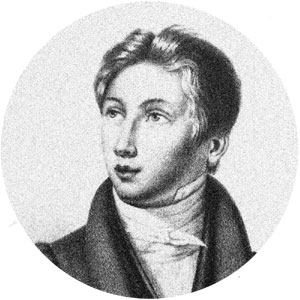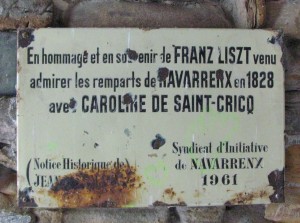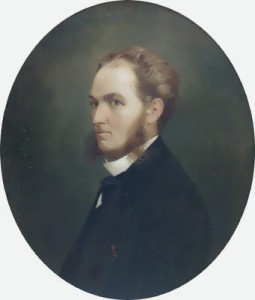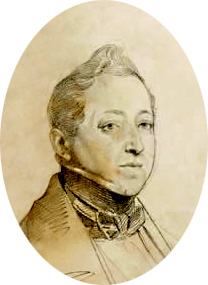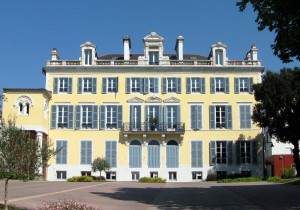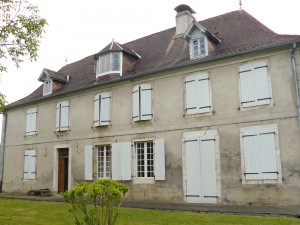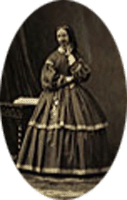Their Romance
You can find ample details about Franz Liszt and his life in the multitude of excellent biographies listed elsewhere on this website (e.g. Alan Walker, Serge Gut). I will focus only on the aspects associated with his affair with Caroline de Saint-Cricq at this site.
Franz Liszt was born on October 22, 1811 in Raiding, a tiny village some ninety kilometer from Vienna. From his early childhood up to the summer of 1827, Liszt’s life had been entirely managed by his father Adam Liszt, a superintendent of the sheep flocks in Raiding in the employ of Prince Esterhazy but also a talented musician, who played cello in the Esterhazy orchestra. Franz had been taught to play the piano and perform in concerts to earn a living for himself and his family. His general education was neglected and outside his piano playing he had little if any time to spare for anything else other than bible-reading.
This all changed when his father Adam Liszt suddenly died, probably from typhoid fever, at Boulogne-sur-Mer on August 28, 1827. Adam Liszt had taken his son there in order he should recover from a cold that he had caught during his English concert tour that Spring.
Franz Liszt (1828)
At only fifteen years of age, young Liszt had the gruesome experience of seeing his father die, having to arrange for his funeral and settle the hospital and funeral debts by selling his Erard grand piano.
Desperate, he wrote to his mother Anna, who lived near Vienna, to join him in Paris. He found a temporary home with the family of the Erard piano maker until his mother arrived. It was Erard who had sponsored Liszt on concert tours (e.g. to England) to promote their new double escarpment grand piano. When his mother arrived several weeks later in Paris in October 1827, they rented a modest apartment at Rue Montholon nr. 7-bis[1].

Rue Montholon 7 (7-bis is in courtyard)
Although the building still exists, present day Liszt fans won’t find any items at Rue Montholon that remind them of the presence of Franz Liszt. The main front double-door entrance opens into stairs to the front side apartments and the small courtyard where the apartment of Franz and his mother was located. It had no street view, which is common for many Parisian apartments. When I visited the place in 2011, classical music was played on a piano in the courtyard, probably by someone who never heard that Liszt used to live there as a youngster.
With the help of Erard, word quickly got round that Liszt was taking on pupils.
Liszt started to give piano lessons[2] late October 1827, barely sixteen years old. Given his reputation as child prodigy[3], it is likely that the Saint-Cricq family asked him to teach Caroline by late 1827, shortly after Caroline’s seventeenth birthday and their romance starting early 1828. We know that the romance took place in 1828 because of the key role that the death of Caroline’s mother Clémence, on June 30, 1828, played in it.
Until now, Caroline’s date of birth has never been mentioned by any of Liszt’s biographers. They estimated her to be anywhere between fifteen and eighteen when she fell in love with Liszt, and they also frequently stated an incorrect age for Liszt. Liszt did not prove to be a good source for information on dates either. It is likely that, dazzled by his love, he wasn’t aware of Caroline’s age. Liszt also wasn’t familiar with (or did not remember in later life) Caroline’s full name or that of anyone else in her family except her father and mother.
To Lina Ramann[4], Liszt specified 1829 as the year of his love for Caroline. This does not align with the death of Caroline’s mother or with his letters towards the end of 1828. From the fact that Liszt stated 1828 (rather than 1827) as being the year of his father’s death to Lina Ramann we can conclude that he was off by one year on these two events.
The piano lessons took place at the Saint-Cricq home[5]in the presence of Caroline’s mother who was quite fond of Liszt. Despite his Raphaelesque beauty, the inexperienced young Franz Liszt had no knowledge of worldly matters. His relationship with Caroline thus remained innocent and platonic. Discussions were focused on music, literature, and religion.
Although Liszt was hired as her teacher, it was Caroline who taught him about life. With her extensive education gained from many private teachers, she introduced him to the works of Hugo, Dante, and Lamartine[6], among others.
The death of Caroline’s mother Clémence brought Caroline and Liszt closer to each other. But regardless of the plea made by her mother on her death bed (according to the romantic biographers) her father, in spite of his modern perspective on life, did not change his view about her betrothal. In aristocratic circles in those days, these matters were arranged by the parents and Caroline’s marriage arrangement was to be no exception.
In the list on the first page of this site you’ll find many references to Liszt biographies and books that all add a very romantic tone to the love affair. In often prosaic lines the fate of the young Liszt is sketched with Caroline’s cruel father showing him the door. From the extensive literature it is clear that Caroline’s father was the opposite of the horrible person depicted in the romantic articles. Stories of the young Liszt in tears leaving the Hôtel of the Saint- Cricq family in the poring rain all add to an atmosphere of fairy tale proportions. These stories are not backed up by any historic data. Practical situation is that Liszt was sixteen at the time and Caroline seventeen and marriage was out of the question.
Being a daughter of a French Minister at the time of her love affair with Liszt, her parents visualized a different destiny for Caroline, than to marry a piano virtuoso who did not belong to the nobility and had only a few incoherent compositions to his name.
The myth of the love affair is taken to new heights with invented stories such as Liszt and Caroline happily embracing their love under an arch of the town of Navarrenx in the Pyrenees in 1828 (memorized by a plaquette placed in 1961). The life and travels of Liszt have been well-documented and it is very clear that Liszt never traveled to the Pyrenees until 1844.
Then there is the story of a certain Charles d’Avila (or Carol Davila) that supposedly was the illegitimate child of Liszt and Caroline. Also this story (which stems from well after Liszt’s death) is ridiculous and has already been dismissed by Doretta Berthoud in 1956 and by Alan Walker in 1980 as ‘bogus’. Anyone with little investigative mind can verify that d’Avila was born in Parma, Italy, on April 8, 1828. The child should have been conceived by the fifteen year old Liszt with the angelic sixteen year old Caroline in July 1827, before the death of his father and during his concert trip to the UK? Other rumors state that Davila was the son of Liszt and D’Agoult, which would also be a miracle with conception some six years before Liszt met Marie D’Agoult. The only truth in the story of the Rumanian Davila family is that they may have been very remote family of Liszt. Liszt’s grandfather was one of twenty-some children and some of them ended up in Rumania.
Carol Davila – Charles d’Avila (by Theodor Aman)
(‘Bogus’ illegitimate child of Liszt and Caroline)
Caroline’s Husband
Caroline’s husband-to-be was Bertrand Dartigaux, born[7] on September 15, 1801 in Oléron (Bearn). The name d’Artigaux, as stated by many Liszt biographers, is incorrect and may have been used to suggest (nonexistent) nobility to the reader. Like the Saint-Cricq family, the Dartigaux family had its roots in the Bearn and has been mentioned “Dartigaux” already in 17th century references.
All official documents use the name Dartigaux, including Caroline’s death certificate and funeral mass[8] announcement. Although Caroline never signed herself with d’Artigaux, she did refer to her husband Bertrand as M. d’Artigaux in several letters[9]. Having married the commoner Dartigaux, Caroline effectively lost the title of Countess.
The Dartigaux and Saint-Cricq families had been well-acquainted for years. Bertrand’s father, Antoine Dartigaux[10] (September 29, 1766 – March 20, 1836) was elected to the House of Representatives in 1815 but dismissed in 1816 after making a violent speech against the Bourbons after which the royalist authorities placed him under surveillance. He was reinstated and became MP from 1819 to 1820 and from 1824 to 1830, but unlike the more flexible Count Pierre de Saint-Cricq, he had to resign after the revolution in 1830.
His wife Josèphe-Marie-Firmine Navarrot was also born at Oléron and came from a family of poets. Antoine and Josèphe had two sons, Bertrand-Lucien-Marie (Bertrand, or Dartigaux-fils) and Marie-Louis-Edouard (Edouard). It was Antoine who arranged the first major appointment of his eldest son Bertrand as deputy to the King’s Attorney at Mont-de-Marsan in 1824. Also with the help of Antoine, his younger son Edouard, born April 8, 1807 in Oléron, became a lawyer at the Pau Royal Court in 1827.
The closeness of the Saint-Cricq and Dartigaux families is further revealed by the fact that several Saint-Cricq family members were buried in the Pau cemetery vault bought by Bertrand Dartigaux in 1836.
Bertrand Dartigaux was a capable man. He was public prosecutor at the Court of Bagneres-de-Bigorre from October 1826 onwards. In August 1828, at the time of Liszt’s love affair with Caroline, he was promoted to public prosecutor at the Court of Pau and thereby proved himself to Count Pierre de Saint-Cricq as an excellent candidate for marriage.
Bertrand Dartigaux (1843)
1831: Marriage of Caroline and Bertrand
Given the friendship between the two families, Caroline’s destiny may have already been decided at the time of her birth. The marriage between Bertrand and Caroline had probably been agreed by their fathers in 1828 after the death of Caroline’s mother and her romance with Liszt. Marriage arrangements for girls around their 17th birthday were common at that time (and still are) amongst the aristocracy[11]. It was the proper thing to do for a loving widowed father who wanted a secure future and home for his pretty daughter and also avoided risks with the many other marriage candidates and the loose scene that existed at aristocratic levels in Paris.
There are no details of Caroline’s activities between the autumn of 1828 and her marriage in March 1831, but if we look at Count Pierre de Saint-Cricq’s governmental activities in those years it is clear that he had no time for her. He probably sent her to a (convent) boarding school to complete her education[12]. Although the arranged marriage between Caroline and Bertrand solved her father’s problems, it is unclear whether Bertrand welcomed this betrothal to a Parisian girl.
The marriage was held in Paris[13] on March 14, 1831. Afterwards, they moved to Hôtel Dartigaux at Rue Henri IV[14] in Pau. It wasn’t the worst place for a twenty-year young aristocratic girl to live! The Dartigaux mansion is known nowadays as Villa Cadoval.
Hôtel Dartigaux, Pau, with spectacular mountain view
There is nothing in Liszt’s letters, or those of his friends, that provides us with an indication that he was aware of, or cared about, Caroline’s marriage.
In June 1832, after his ministerial role for King Louis-Philippe, Caroline’s father and widower Count Pierre de Saint-Cricq moved back to his home region of Pau, where he became president of the General Council of the Pyrenees-Atlantiques region. It is not surprising to find that his successor to this function, from January to July 1833, was his son-in-law: Bertrand Dartigaux.
Bertrand Dartigaux became President of the court of Pau in 1837. For this last promotion he was rewarded with the title of Knight so could consider himself part of nobility (albeit at the lowest level).
Besides their Hôtel and house in Pau, the Dartigaux family owned farmland with a large country farmhouse and a chapel in the town of Moncayolle, a mere five kilometers away from the Saint-Cricq castle in Sus. Very likely Count Pierre de Saint-Cricq and Antoine Dartigaux had been friends since childhood.
Dartigaux country farmhouse, Bouhateguy, Moncayolle
Caroline bore Bertrand a daughter, Berthe (November 20, 1835). Her full name was Laurence-Henriette-Berthe-Isabelle Dartigaux. Little is known about Berthe’s childhood other than her many illnesses (see further down in this essay), her move towards mystical religion as an adolescent and her activities to fund a Carmelite cloister in Bethlehem after the death of her parents.
Miniature image of Berthe[15] (1859)
Next: Caroline’s life in Pau
[1][↑] They first rented a temporary apartment at Rue Coquenard nr. 33: See Serge Gut, Franz Liszt, Studio-Verlag (updated German edition), 2009, p 701.
Rue Coquenard (presently Rue Lamartine) basically continued onto Rue Montholon.
[2][↑] We should keep in mind that there is a substantial difference between the piano lessons that Liszt gave to the sons and daughters of aristocrats and the teachings he did later in life (albeit starting with Wilhelm Von Lenz in 1828). The first were primarily about mastering the instrument. The second were Master Classes, in private or with a group of pupils (disciples), where one was expected to have overcome all technical hurdles prior to entering the class. Except for the few first years of piano lessons Liszt never demanded payment for his teaching.
[3][↑] The book compiled by Christopher Howard Gibbs, Dana Andrew Gooley, Franz Liszt and his world, Essays from the Bard Music Festival, Princeton, 2006, p. 360 suggests that the Saint-Cricq family may have met Liszt at the St. Vincent de Paul church at rue Montholon. The abbé of this church and confessor to Liszt was Jean-Baptiste Bardin. See Les Cahiers Boëllmann-Gigout, n° 2/3, Dec. 1997/March 1998, by Association Boëllmann-Gigout, Paris. A book by another abbé of this church, Henry Doisy, La Paroisse et l’église Saint-Vincent-de-Paul de Paris, Paris, Wolf, 1942, includes Liszt on p. 295 but only mentions that Caroline’s father has been a marriage witness (p. 204). They could have also learnt about Liszt taking on students via the piano maker Erard or via the girl school of a Madame Alix where Liszt was giving lessons. It may also have been word-of-mouth: Another student with the same age as Caroline was Georgina Granville Leveson-Gower. She was a daughter of the English ambassador Lord Granville, a friend of the Saint-Cricq family. Lord Granville had been involved in arranging travel permits for Liszt’s Erard promotion tours to England in 1824, 1825, and 1827.
[4][↑] Lina Ramann, op. cit. 3. p. 36, p. 404.
[5][↑] Several biographers state that the piano lessons took place at Count Pierre’s government residence at 116 Rue de Grenelle, presently the town hall of the 7th Paris district. It is unlikely that the Saint-Cricq family moved to this office location. It had been in the possession of the duke of Brissac and was confiscated by the government after the 1792 revolution. Its apartments were transformed by the architect Roucelle into offices. It was the home of the Saint-Cricq’s ephemeral Ministry department of Commerce between Jan. 1828 and Aug. 1829, but the building was returned to the Brissac family by 1829. For most of his governmental responsibility, the Count had offices at the Hôtel d’Uzès at Rue Montmartre 176 (this building no longer exists). During his position as Minister, the Count’s meetings were held at the offices of the Ministry of Finance at Rue de Rivoli. The Count owned several apartments in Paris, e.g. Rue Montmartre 76 and Rue de Provence 67 (from 1815 onwards). Several archives indicate the main residence of the Saint-Cricq family to be a luxurious location at 3 Rue Royale, Saint Honoré (from 1826 onwards).
[6][↑] Eric van Zalingen, L’Influence de Littérature sur Franz Liszt, Faculty Humanity Thesis University Utrecht, 2006.
[7][↑] Archives Pyrénees Atlantique (earchives.cg64.fr), Oléron archive fiche 5MI422-9 view 1326/1536. Bertrand’s official date of birth is 4 p.m. at 28 Fructidor of Year IX of the French Republican Calendar.
[8][↑] Invitation to funeral mass, procession, and burial of Caroline. Written April 16, 1872. Original handwritten document in possession of author.
[9][↑] La Mara, Aus Der Glanzzeit Der Weimarer Altenburg: Bilder und Briefe Aus Dem Leben Der Furstin Carolyne Sayn-Wittgenstein, Leipzig, Breitkopf & Härtel, 1906, Letters 37 & 190. In absence of original copies of Caroline’s letters it remains unclear if she actually used the name d’Artigaux or that this was erroneously done by La Mara.
[10][↑] Assemblee Nationale, Base de Données des Députés Français depuis 1789 (to be found at assemblee-nationale.fr/sycomore/fiche.asp?num_dept=16586).
[11][↑] See also: Honoré de Balzac, Le Contrat de Mariage, Paris, Gallimard, 1835. The number of illegitimate children in Paris during this period was close to thirty percent. Liszt and Marie d’Agoult’s extramarital affair was considered nothing special.
[12][↑] Parents were generally removed from their children’s day-to-day upbringing. This was the norm in upper-class families of that era. Both Marie d’Agoult and George Sand, for example, spent their youth at boarding schools and had arranged marriages (at twenty-one and eighteen years of age, respectively). Liszt and d’Agoult left their baby Blandine with friends in Geneva until she was three years of age and continued their journey to Rome. They later on placed Cosima and Blandine at a boarding school. The boarding school (usually a convent school for girls) may have further stimulated Caroline’s ideas about taking the veil: a reason for her father to make sure she got married.
[13][↑] Paris Archives, Fiche V3E/M255, page 339, and Léon-Bérard, op.cit 4, p. 688.
[14][↑] Original street name was Rue Henri IV, later renamed Rue Napoleon, Rue de Collège, Rue de Lycée and, since 1934, Rue Louis-Barthou.
[15][↑] Photo image, one of a series of 7 “carte de visite” images, by André-Adolphe-Eugène Disderi, Paris, 1859. Courtesy A Gallery, New Orleans, USA, agallery.com. For Liszt collectors: These images are for sale.

